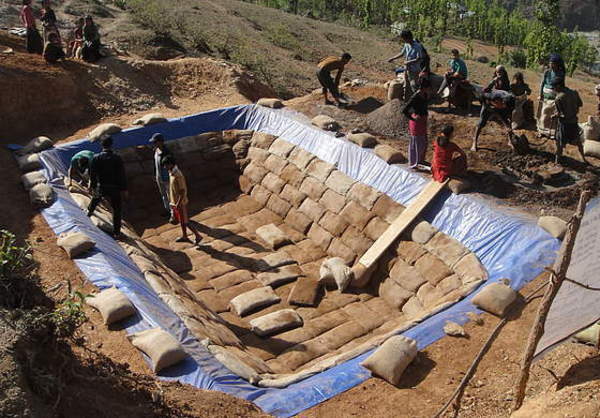
“For irrigation purposes, especially for fresh vegetable cash crop production in water deficit areas, water is collected in ponds from springs or small streams. The ponds are lined and sealed with sheet membranes (200 g/m2 fibre-reinforced plastic sheets, Silpaulin). The sheets are water proof; less affected by earth-movements, affordable for small farmers and can be easily repaired in case of small tears. However the sheets are photosensitive and tend to become brittle when directly exposed to the sun, especially when ponds are empty or filled with less water.
To improve the functionality and sustainability of the ponds the sheet membrane is protected from the sun – ultraviolet radiation and heat – and damage by other external factors such as stones, sharp items and fire. by a soil-cement jute bag lining. Compared with cement stone masonry or even concrete ponds, soil/cement jute bag lining has been found more useful and cost effective and is comparatively easy to apply. The soil/cement jute bags are packed with a mixture of cement and soil in the ratio of 1:12 and are laid over the sheet membrane. Approximately 50 jute bags and 3.5 bags cement are required to cover 10 square meter surface area. The technology is simple and easily understood and appreciated by the users.”
Helvetas
A big thank you to Abe for recommending this process. Reader contributions are much appreciation. Vast areas of the world lack sufficient year-round water supplies so ideas such as this one are very important. This story also goes to show how earthbags have many uses.
Compare to the earthbag water tanks in the South Pacific islands of Vanuatu.

Appreciate your good work!
Can we replace the cement sand bags with lime mud jute bags? They would be more eco friendly and economical as well.
This might work, but would require some experimentation.
I really love this idea, low cost and easy to construct
I love this idea. I wanted to install a pond on my property and this way looks much more affordable and manageable than the other options I was exploring. Depending on the size, manual labor can also be used to complete the process. In Ghana, aside from the labor, the cement, dirt and bags would cost less than US$175.
That’s a LOT of water for $175. It’s enough to water a big garden and orchard and pets.
In some countries there are government farm subsidies and/or coops to defray the cost of farm ponds. Sometimes there is a village or district coop that work together to pay part of the excavation. The excavator gets their gas and labor covered and they in turn can sell the excavated soil to raise building sites. Fly over Thailand for instance and you’ll thousands of ponds like this everywhere, so there are probably millions in the whole country.
Earthbags have dozens of uses as we’ve thoroughly documented here on our blog. Sooner or later one or more of these ideas will really catch on and go viral. In a country like India, for example, there are countless thousands of these ponds. Do a google image search and you’ll see most of India has drought conditions and so farmers must save up water during the rainy season to get by.